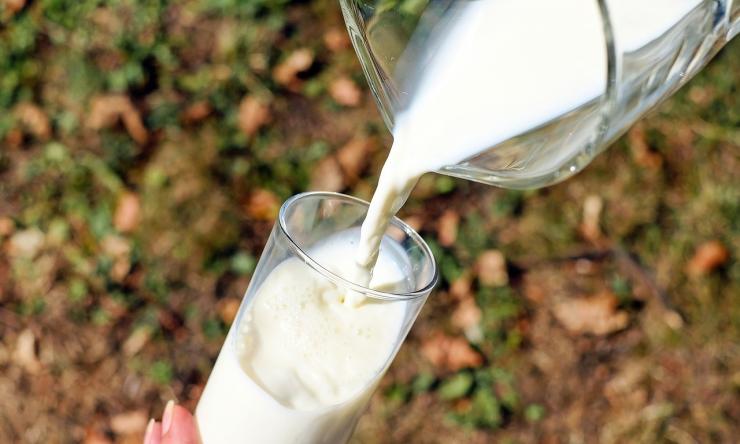Cow milk vs. alternative milk: what’s the best?
With a wide variety of dairy and nondairy milks on the market, consumers have endless options when it comes to choosing milk to quench their thirst, make their morning coffee smooth and velvety or enhance their cereal and oatmeal. People with different dietary needs or goals also can find ample milk selections and alternatives. A Baylor College of Medicine registered dietitian breaks down the components of different milks.
Cow milk
Cow’s milk naturally contains nutrients, including calcium, vitamin D, vitamin A, B2 (riboflavin), B12, and minerals such as magnesium, zinc, potassium and phosphorus. Cow’s milk is high in protein and contains much more protein than most plant-based milks. While it contains a source of saturated fat, which is less heart healthy than unsaturated fats, you can opt for skim or nonfat milk for a less fatty option.
“All of the dairy milks have similar amounts of calcium and vitamin D. Choosing the type of cow’s milk to drink depends on the stage of life that you’re in and what your goals are,” said Sarah Mahlke, senior program management associate at the Weight Loss and Metabolic Center at Baylor Medicine
If you want to diet or lose weight, nonfat or skim milk are the best options. If you crave more flavor and creaminess without the added calories of whole milk, you can opt for 1% or 2% milk. For a child who recently weaned off breastmilk and is switching to cow’s milk, she recommends whole milk because children need fats to grow their brain and calories in their diet. She notes that some milks have started fortifying with DHA omega-3 fatty acids, which are the heart healthy oils found in fatty fish.
“DHA is an especially important nutrient for brain development as the brain is about 60% fat by weight. For this reason, a cow’s milk fortified with DHA might be a good option to give a 1-year-old after weaning from breast milk or formula,” she said.
Mahlke does not recommend drinking raw or unpasteurized milk due to food safety concerns.
Soy milk
Soy milk is most comparable to cow’s milk from a protein standpoint. Soy milk is fortified with calcium and vitamin D. While other plant-based milks may contain added calcium and vitamin D, soy milk is most likely to be fortified with these nutrients.
“In order to be labeled as a vitamin D-fortified milk, there are minimum and maximum amounts that must be added to the product, so any milk product labeled as ‘fortified with vitamin D’ will have similar amounts,” she said. “For any plant-based milk, it’s important to check the package and label to make sure you are receiving the benefit of these added nutrients.”
Soy milk might be sweetened or unsweetened, so try to opt for the unsweetened version to control your added sugar intake.
Research suggests that a higher intake of phytoestrogens, which are compounds found in soy products, beans, lentils, certain seeds and some fruits and vegetables, is associated with a lower risk of mortality.
Almond milk
Almond milk is a lower-calorie option over cow and soy milk, and that is largely because it has so little protein and carbohydrates if unsweetened. Almond milk contains vitamin E and small amounts of unsaturated fat, which are heart healthy, and some also are fortified with calcium and vitamin D. Almond milk also contains arabinose, a type of carbohydrate, which has been shown to improve metabolic syndrome in rodent models. Similar to other plant-based milks, this can be high in sugar if you choose the sweetened version.
While nuts have a lot of nutritional value, that nutritional content does not fully translate over to nut milks. The processing involves grinding and extracting food substances with water, and often uses very high temperature technologies to increase the product’s shelf life. These processing methods can result in the loss of certain nutritional properties and bioactive compounds. Fiber is also removed during processing, which creates a less satiating product.
Oat milk
While oat milk contains more protein than almond milk, it still lags behind cow and soy milk for adequate protein. Like other plant-based milks, it can have calcium and be fortified with vitamin D.
Oat contains a functional compound known as β-Glucan, which is associated with improved blood glucose and insulin resistance. Oat milk also contains phytates that bind to certain minerals such as calcium and reduces their absorption.
Purchasing plant-based milks can be confusing. Some are labeled as “unsweetened” or “no sugar added,” but it can be hard to tell which ones have added sugars, so check the nutrition facts to understand the number of grams of added sugar.
Choosing the right milk for you
Across all milks, think about your needs and goals. Whether you want to avoid a certain ingredient, get more protein or consume fewer calories, there should be a milk available for anyone.
Because cow’s milk is high in potassium and phosphorus, it is not suitable for people with chronic kidney disease who need to avoid high amounts of these nutrients. Soy and oat milk also have considerable amounts of potassium and phosphorous, so almond milk would be the most appropriate option for this population.
“If you’re looking for a high-protein product, cow milk and soy milk are the best options. If you want something lower calorie that doesn’t need to meet your protein needs, a plant-based product might be the right thing,” Mahlke said. “Maybe you’re just going for taste, which is important too, because at the end of the day, food makes us happy, and that’s a good thing!










